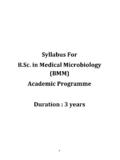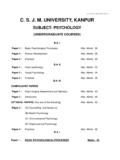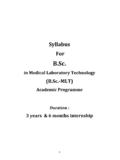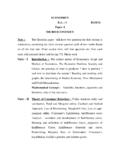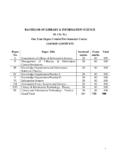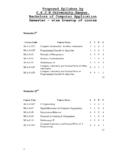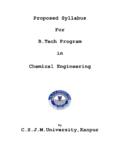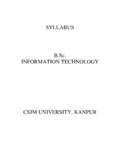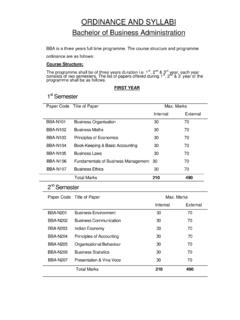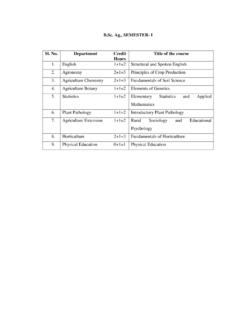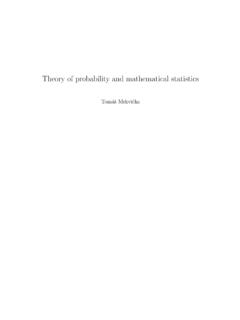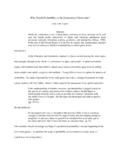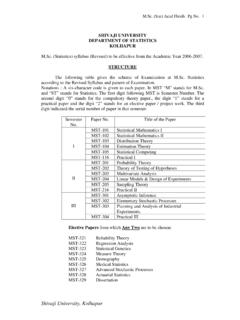Transcription of Unified Syllabus of Statistics Course Instruction
1 Unified Syllabus of Statistics Course Instruction Part- I & Part - II There will be three papers of 3 hours duration of 50 marks in each. Practical will be of 50 marks & three hour duration in each year. Part- I & Part - II There shall be two theory papers of three hour duration of 33 marks each. Practical will be of 34 marks & three hour duration in each year. Part-III There will be three theory papers of three hour duration & 75 marks each. Practical would be of 75 marks & three hour duration. Part - III There will be three theory paper of three hour duration & 35 marks each. Practical would be of 45 marks & three hour duration. Proceeding of Board of Studies in Statistics Held on At 12 Noon At University Kanpur In Principle Board agrees with the circulated Syllabus of Classes in Statistics .
2 However following observations would make it more relevant. 1. Contents in II / II paper II entiled Survey sampling Seem to be lengthy. The following topic of the paper may be deleted : Double sampling in ratio method of estimation , Two stage sampling with equal first stage unit, Estimator of population mean and variance , Non sampling error. 2. The Syllabus of B. A I and B. A- II consists of two papers each . Board feels that there may be three papers in each class. 3. Syllabus may be common for all the papers in each year. 4. To maintain the uniformity in all respect, Board feels that infrastructure should also be the same in all state universities and degree colleges.
3 All degree department should have faculty of at least three persons 5. All the Departments should have the sufficient computer systems to replace the old one (the calculators ) for the Pratical Purpose. 6. There may be an optional papers of computer programming with FORTRAN Unified Syllabus OF Statistics Part- I Paper I : Probability & Probability Distributions UNIT I Random experiment, trial, sample point and sample space, events, operations of events, concepts of equally likely, mutually exclusive and exhaustive events. Definition of probability : Classical, relative frequency and axiomatic approaches. Discrete probability space, properties of probability under set theoretic approach Independence of events, Conditional probability, total and compound probability theorems, Bayes theorem and its applications.
4 Random variables discrete and continuous, probability mass function (pmf) and probability density function (pdf), Cumulative distribution function (cdf). UNIT II Joint distribution of two random variables, marginal and conditional distributions, Independence of random variables. Expectation of a random variable and its properties., expectation of sum of random variables and product of independent random variables, conditional expectation and related problems. Moments, moment generating function ( ) & their properties, continuity theorem for (without proof).Chebyshev s inequality. Weak law of large numbers and Central Limit Theorem for a sequence of independently and identically distributed random variables and their applications.
5 UNIT III Univariate distributions: Binomial, Poisson, Hypergeometric, Geometric and Negative Binomial. Uniform (discrete & continuous), Normal, Exponential, Gamma, Beta distributions. Cauchy, Laplace, Pareto, Weibull, Log normal Distributions. Normal and Poisson distributions as limiting case of binomial distribution. UNIT IV Distributions of function of random variables: Distribution of sum, product and quotient of two variables. Reproductive property of standard distributions. 2(chi-square), t and F distributions ( Central cases only) and their limiting forms. Bivariate normal distribution and its properties. REFERENCE: 1. Parzen, : Modern Probability Theory and its Applications.
6 2. Meyer, P. : Introductory Probability and Statistical Applications. 3. Stirzekar David (1994) : Elementry Probabilityu, Cambridge University Press. 4. Mood , Graybill and Boes (1974) : Introduction to the theory of Statistics , McGraw Hill. 5. Mukhopadhyay, P : Mathmatical Statistics , new central book agency. Unified Syllabus OF Statistics Part- I Paper II : Statistical Methods and Numerical Analysis UNIT-I Concept of statistical population, Attributes and variables (discrete and Continuous). Different types of scales nominal, ordinal, ratio and interval. Primary data designing a questionnaire and schedule, collection of primary data, checking their consistency.
7 Secondary data; scrutiny of data for internal consistency and detection of errors of recording. Ideas of cross validation. Presentation of data; classification, tabulation, diagrammatic & graphical representation of grouped data. Frequency distributions, cumulative frequency distributions and their graphical representations, histogram, frequency polygon and ogives. Stem and Leaf Plot. Box Plot. Measure of central tendency and dispersion, merits and demerits of these measures. Moments and factorial moments. Shephard s correction for moments. Skewness and Kurtosis and their measures. Measures based on quartiles.
8 UNIT-II Bivariate data, Method of least squares for curve and regression, rank correlation (Spearman s and Kendall s measure). Intra-class correlation, correlation ratio. Partial and Multiple Correlation & Multiple Regression for Tri-variate data. UNIT III Attributes- Notion and terminology, contingency table, class frequencies, and ultimate class frequencies, consistency. Association of attributes, Independence, Measure of association for 2x2 table. Chi-square, Karl Pearson s and Tschuprow s coefficient of association. Contingency tables with ordered categories. UNIT IV Calculus of finite differences, operators, separation of symbols, examples and problems.
9 Interpolation formulae with remainder term. Newton s forward and backward formulae. Central difference formulae. Newton s divided difference formulae for interpolation. Lagrange s interpolation formulae. Numerical Integration: Derivation of general quadrature formula for equidistant ordinates. Derivation of trapezoidal, Simpson s 1\3rd and 3\8th rules. Weddle s rule. Numerical differentiation using Newton s forward and backward formulae. REFERENCES 1. Parzen, : Modern Probability Theory and Its Applications. 2. Meyer, P.: Introductory Probability and Statistical Applications. 3. Freeman : Finite Differences.
10 4. Scarborough: Numerical Analysis. 5. Sastry : Introductory Methods of Numerical Analysis; Prentice Hall of India Pvt. Limited. 6. Jain, , Iyengar, SRK and Jain : Numerical Methods For Scientific And Engineering Computations; NEW AGE International (P) Limited. 7. Goon,Gupta & Dasgupta: Fundamentals of Statistics . Vol. I. The world press Private Ltd., Calcutta. 8. Yule, and Kendall, : An Introduction to the theory of Statistics . Charles Griffin & Company Ltd. 9. C. E. Weatherburn: Mathematical Statistics . 10 Saxena, : Calculus of Finite Differences (S. Chand & Co.). Part- I PRACTICAL The practical examination will be based on papers I and II and will cover the following experiments.
